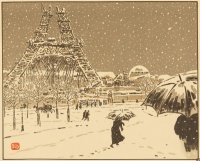Henri Rivière (painter)
From The Art and Popular Culture Encyclopedia

|
Related e |
|
Featured: |
Henri Rivière (1864-1951) was a French artist and designer best known for his creation of a form of shadow play at Le Chat Noir cabaret, his illustrations of Breton landscapes and his Thirty-Six Views of the Eiffel Tower (1902).
Contents |
Early life
Rivière was born in Paris. His father ran a haberdashery in the city. In 1870, fleeing from the advancing Prussians during the Franco-Prussian war, his father moved the family back to his childhood home in the Pyrenees. He died three years later and Rivière's mother returned to Paris and remarried. Rivière grew up in Paris, showing an early interest in art, especially Impressionism.
After a brief period working at an ostrich-feather importation business, Rivière signed on for formal training in art with the painter Emile Bin. From 1880, he was contributing illustrations to magazines and journals.
Rivière soon became associated with the cabarets in Montmartre, especially the popular Chat Noir (Black Cat) café. From 1882, Rivière worked as part of the editorial team on the weekly Chat Noir journal, which published light verse, short stories and illustrations. Rivière edited and contributed art and reviews to the journal until 1885.
Shadow plays
In 1886 Rivière created a form of shadow theatre at the Chat Noir under the name "ombres chinoises". This was a notable success, lasting for a decade until the cafe closed in 1897. He used back-lit zinc cut-out figures which appeared as silhouettes. Rivière was soon joined by Caran d'Ache and other artists, initially performing d'Ache's drama L’Epopee. From 1886 to 1896, Rivière created 43 shadow plays on a great variety of subjects from myth, history and the Bible. He collaborated with many different artists and writers, but made the illustrations for only 9 of the productions himself. He concentrated on improving the technical aspects of the production using enamelling and lighting to create extremely delicate effects of light and colour. The Ombres evolved into numerous theatrical productions and had a major influence on phantasmagoria. (Phillip Dennis Cate and Mary Shaw (eds), The Spirit of Montmartre: Cabarets, Humor and the Avant-Garde, 1875-1905, Rutgers University Press, 1996.)
According to historians Phillip Cate and Mary Shaw, Rivière's work involved both aesthetic and technical innovations,
Essentially, Rivière created a system in which he placed silhouettes of figures, animals, elements of landscapes, and so forth, within a wooden framework at three distances from the screen: the closest created an absolutely black silhouette, and the next two created gradations of black to gray, thus suggesting recession into space. Silhouettes could be moved across the screen on runners within the frame.<ref name = "phil"/>
Along with d'Ache's L’Epopee, Rivière's own works Le Temptation de Saint Antoine (1887) and La Marche a L'etoile (1890), were the most successful and popular. Rivière's shadow theatre was the cabaret's greatest attraction and "played a crucial role in establishing the credibility of the cabaret with that other tier of the avant-garde, the Impressionists/Post Impressionists: Edgar Degas, Camille Pissarro, Claude Monet, Mary Cassatt, and others."<ref name = "phil"/>
Prints
Between 1882 and 1886 Rivière created a large number of etchings. He also showed an interest in photography, making a series of picturesque scenes of everyday life. He later experimented with colour woodcuts and chromolithography in the late 1880s. Rivière first visited Brittany in 1884, spending most of his summers there until 1916. Together with bustling Parisian life, rural Brittany constituted the majority of the subjects of his landscape works.
Rivière’s prints were generally intended to be published as collections. These include forty images used in Breton Landscapes, created between 1890 and 1894. He also made colour woodcuts for The Sea: Studies of Waves, and prepared other sequences that were remained unfinished, including 36 Views of the Eiffel Tower, which were eventually published as lithographs. These were influenced by the vogue for Japonism at the time, modernising the famous prints by Hiroshige and Hokusai of 36 Views of Mount Fuji.
His colour lithographic series' include:
- The Aspects of Nature (1897 to 1899), 16 images
- The Beautiful Land of Brittany (1897 to 1917), 20 images
- Parisian Landscapes (1900), 8 images
- The Magic Hours (1901 to 1902), 16 images
- Thirty-Six Views of the Eiffel Tower (1902), 36 images
- The Noirot Wind (1906), 4 images
Rivière ceased making prints in 1917, effectively retiring as a professional artist, but continued to work on watercolours in his later years. He died on August 24, 1951.
Linking in as of Dec 2021
1951, 2022 in public domain, Émile Bin, Émile Goudeau, Félix Bracquemond, Georges Fragerolle, Henri Rivière, Jean Cras, Le Chat Noir, List of artists represented in the National Museum of Western Art, Tokyo, List of street photographers, Musée de Montmartre, Pension Gloanec, Shadow play, Silhouette, Thirty-six Views of Mount Fuji
See also

